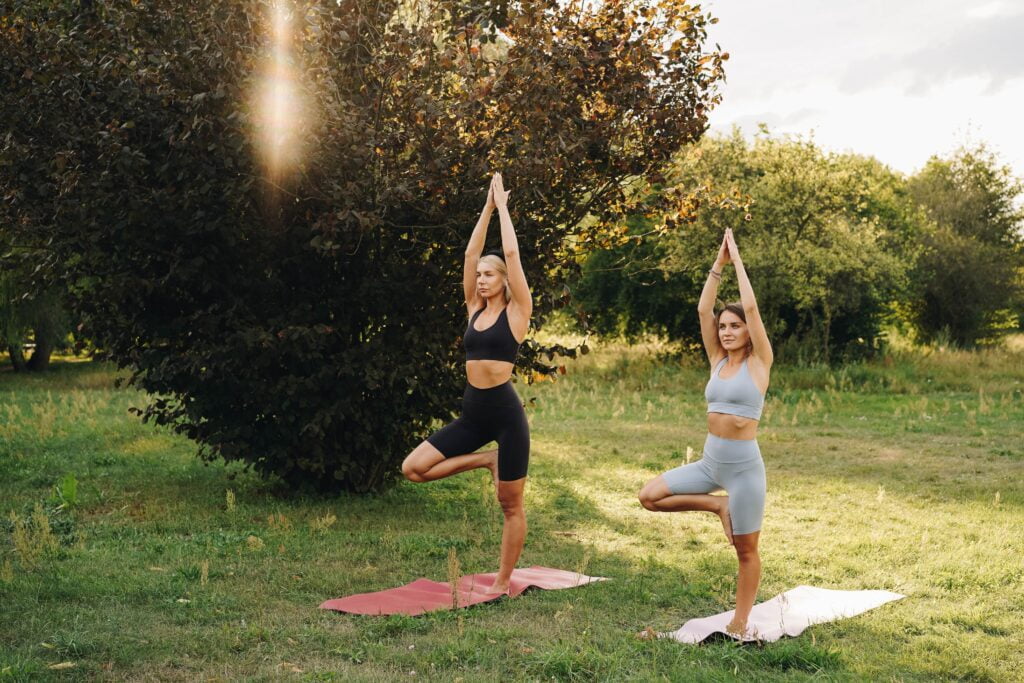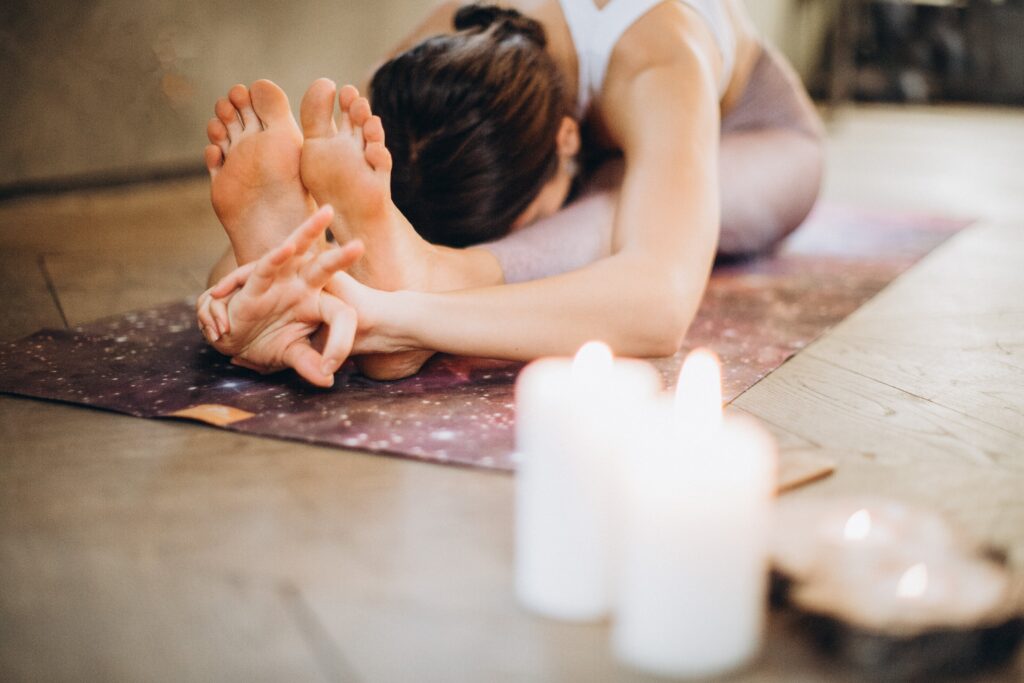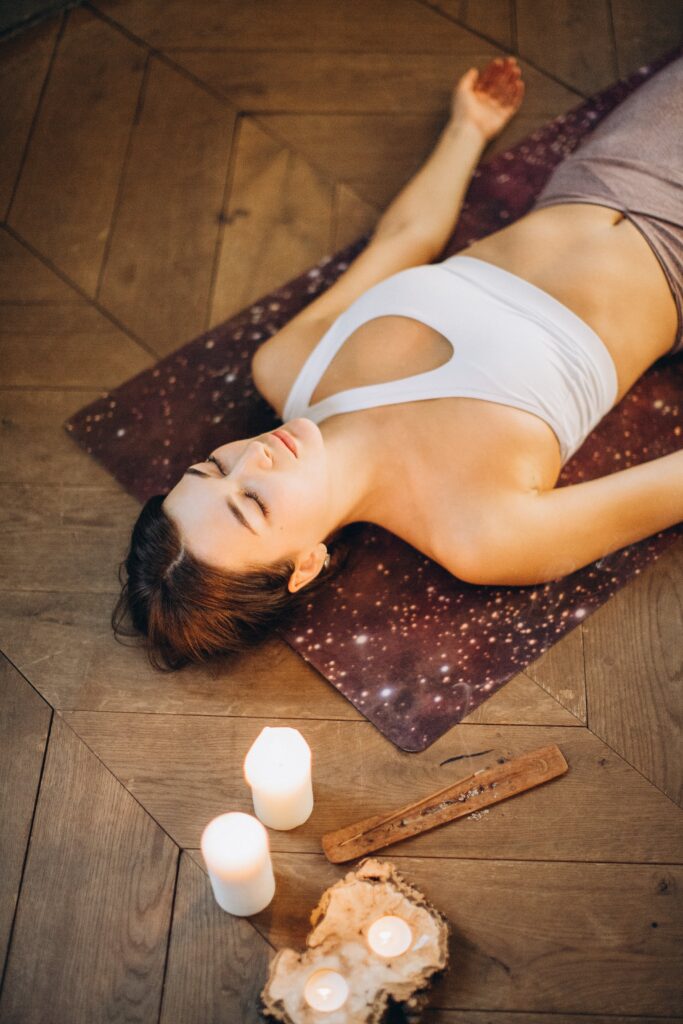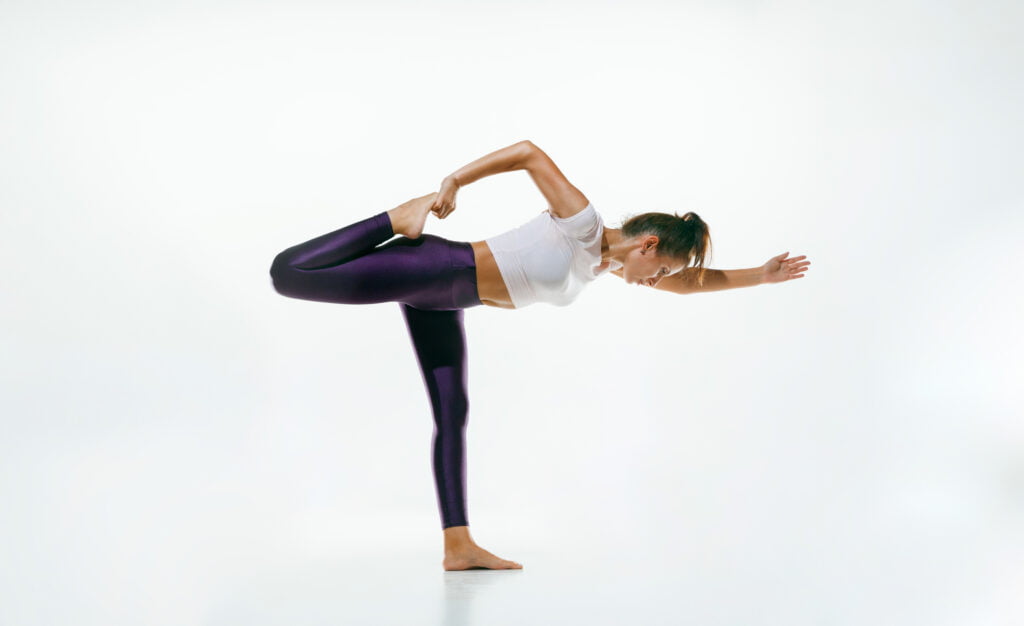Introduction
Yoga Poses for Mental and Physical Wellness: In the hustle and bustle of modern life, the pursuit of well-being has become more crucial than ever. Striking a harmonious balance between mental and physical health is not just a goal; it’s a journey toward a more fulfilling and vibrant existence. Enter the world of yoga – a transformative practice that transcends the boundaries of conventional exercise, offering a holistic approach to wellness.
Yoga is more than just a series of physical postures; it is a mindful journey that intertwines breath, movement, and mental focus. In this exploration, we delve into the profound impact that specific yoga poses can have on your mental and physical well-being. With the title, “Transform Your Well-being: 10 Powerful Yoga Poses for Mental and Physical Wellness,” as our guiding beacon, we embark on a journey to discover the transformative power encapsulated within each pose.
Join us as we uncover a collection of yoga postures, each carefully selected for its ability to strengthen the body and nurture the mind. These poses are not just exercises but gateways to a renewed sense of balance, clarity, and resilience. As we navigate this series, the aim is clear: to empower you with a toolkit of yoga poses that can transform your well-being. Get ready to embark on a journey of self-discovery, where the mat becomes your sanctuary and each poses a step towards a healthier, more vibrant you.
10 Powerful Yoga Poses for Mental and Physical Wellness
Mountain Pose: Tadasana
Description:
Mountain Pose, or Tadasana, serves as the foundational posture in many yoga sequences. It is a standing pose that focuses on grounding the body and fostering a sense of stability. In Tadasana, the practitioner stands with feet together, arms by the sides, and weight evenly distributed across both feet. The spine is elongated, shoulders are relaxed, and the gaze is forward, creating a posture that mimics the strength and stillness of a mountain.

Benefits:
Postural Alignment:
Mountain Pose helps in aligning the spine, promoting better posture. By standing tall with shoulders back, it counteracts the slouched posture often adopted in daily life.
Strengthening:
While it may seem simple, holding the pose requires engaging various muscle groups, including the thighs, core, and ankles, which helps in strengthening these areas over time.
Balance and Focus:
Tadasana enhances balance and concentration. The act of finding stability in the pose encourages practitioners to focus on the present moment, fostering mindfulness.
Improves Awareness:
The pose encourages awareness of body alignment and weight distribution. This mindfulness can carry over into daily activities, promoting better body awareness and balance.
Disadvantages:
Low Intensity:
Mountain Pose is a foundational pose, and while it offers benefits in terms of alignment and awareness, it may not provide the cardiovascular or muscular workout that some practitioners seek.
Limited Challenge:
For more advanced practitioners, Tadasana may feel less challenging compared to other standing poses. Those seeking intense physical challenges may need to incorporate additional poses into their routine.
Potential for Hyperextension:
If not practiced with proper alignment, there is a potential risk of hyperextension in the lower back, which can lead to discomfort or injury. It’s crucial to engage the core muscles and avoid overarching the spine.
Virabhadrasana
Description:
Warrior II, or Virabhadrasana II, is a dynamic standing pose that embodies strength, resilience, and focus. Named after a fierce warrior from Hindu mythology, this asana involves standing with legs wide apart, arms stretched parallel to the floor, and the torso facing sideways. The front knee is bent, aligning directly over the ankle, while the back leg remains straight. The gaze is directed over the front hand, creating a powerful and expansive stance.

Benefits:
Strength Building:
Warrior II is renowned for its capacity to build strength, particularly in the quadriceps, hamstrings, and calf muscles. The isometric engagement of these muscle groups contributes to overall lower body strength.
Hip Opening:
The wide stance and turned back foot in Warrior II encourage hip opening. This can be particularly beneficial for individuals who spend long hours sitting, helping to alleviate tension in the hips and lower back.
Improved Concentration:
Holding the pose requires mental focus to maintain balance and alignment. Regular practice of Warrior II can enhance concentration and cultivate a sense of presence, bringing mindfulness to the current moment.
Stability and Endurance:
The pose challenges stability by engaging the core and lower body. As the body holds the position, endurance is gradually built, contributing to increased stamina over time.
Disadvantages:
Strain on Front Knee:
Improper alignment, such as the front knee extending beyond the ankle, can lead to strain on the knee joint. It’s crucial to ensure that the knee is aligned directly over the ankle to prevent potential injuries.
Shoulder and Neck Tension:
Holding the arms in an extended position can lead to tension in the shoulders and neck, especially for those with pre-existing shoulder issues. Practitioners should be mindful of maintaining relaxed shoulders and neck alignment.
Not Suitable for Certain Injuries:
Individuals with hip, knee, or shoulder injuries may find Warrior II challenging or uncomfortable. It’s advisable to modify the pose or consult with a yoga instructor or healthcare professional for personalized guidance.
Tree Pose: Vrikshasana
Description:
Tree Pose, or Vrikshasana, is a standing balance pose that emulates the grace and stability of a tree. In this asana, practitioners stand on one leg while the opposite foot is placed on the inner thigh or calf of the standing leg, with arms stretched overhead. The hands are often brought together in a prayer position at the chest or raised toward the sky, resembling the branches of a tree.

Benefits:
Enhanced Concentration:
The act of balancing in Tree Pose requires intense focus and concentration. This helps quiet the mind and brings attention to the present moment, promoting mental clarity.
Strengthens Legs:
The weight-bearing nature of Tree Pose strengthens the muscles in the standing leg, including the thighs, calves, and ankles. This can contribute to improved leg strength and stability over time.
Improved Balance:
Regular practice of Vrikshasana improves balance and stability, benefiting individuals who may struggle with equilibrium. This can be particularly beneficial for older adults or those recovering from injuries.
Fosters Calmness:
The meditative quality of Tree Pose, combined with controlled breathing, fosters a sense of calm and tranquility. It provides a moment of stillness amid the dynamic flow of a yoga practice.
Disadvantages:
Risk of Falling:
Balancing on one leg may pose a risk of falling, especially for beginners or those with balance issues. Practitioners should use a support, like a wall or chair, until they develop the necessary strength and balance.
Strain on Knee Joints:
Placing the foot too high on the inner thigh may exert excessive pressure on the knee joint. It’s essential to position the foot at a comfortable height to avoid strain.
Challenges for Certain Health Conditions:
Individuals with issues such as low blood pressure, vertigo, or certain vestibular disorders may find balancing poses, including Tree Pose, challenging. Modifications or alternative poses may be necessary.
Child’s Pose: Balasana
Description:
Child’s Pose, or Balasana, is a restorative and grounding yoga posture that is often used as a resting position during a yoga practice. In this pose, the practitioner kneels on the mat, sits back on the heels, and then folds forward with the forehead resting on the floor or a prop. The arms can be extended forward or relaxed by the sides, promoting a gentle stretch and a sense of surrender.

Benefits:
Restorative Relaxation:
Child’s Pose is renowned for its restorative qualities, providing a moment of relaxation and rest during a yoga sequence. It allows the body to recover and rejuvenate.
Spine Stretch:
The forward folding position in Balasana gently stretches the spine, promoting flexibility and releasing tension in the back. It can be particularly soothing for those who spend long hours sitting or standing.
Hip and Thigh Release:
The sitting position and the gentle stretch in the hips and thighs help release tension in these areas. This can be beneficial for individuals with tight hip muscles.
Calming Effect on the Mind:
The act of folding forward and turning inward in Child’s Pose promotes a sense of introspection and calmness. It is often used as a pose for mindfulness and stress relief.
Disadvantages:
Not Suitable for Everyone:
Individuals with knee or ankle injuries may find the kneeling position uncomfortable. Modifications, such as placing a cushion under the knees, may be necessary.
Limited Physical Engagement:
Child’s Pose is a passive stretch and does not actively engage muscles for strengthening. While it’s excellent for relaxation, it may not provide the physical challenge sought by those looking for a more vigorous practice.
Potential for Overstretching:
Individuals with hypermobility or excessive flexibility may need to be cautious in Child’s Pose to avoid overstretching, especially in the shoulders and lower back.
Cobra Pose: Bhujangasana
Description:
Cobra Pose, or Bhujangasana, is a rejuvenating backbend that mimics the posture of a cobra with the upper body lifting while the lower body remains grounded. In this pose, practitioners lie on their stomachs, place their palms under their shoulders, and lift their chest, arching backward. The legs remain extended with the tops of the feet pressing into the mat, creating a gentle curve in the spine.

Benefits:
Spinal Strength:
Cobra Pose is highly effective in strengthening the muscles along the spine. Regular practice can contribute to improved spinal flexibility and resilience.
Chest Opener:
The backbend opens the chest and stretches the front of the torso, promoting better posture and alleviating tension in the chest and shoulders.
Stimulation of Nervous System:
The arching position of Cobra Pose stimulates the nerves along the spine, awakening and rejuvenating the nervous system. This can lead to increased energy and alertness.
Mood Elevation:
Backbends are known for their mood-enhancing effects. Cobra Pose, in particular, can help alleviate stress and anxiety, promoting a sense of well-being and positivity.
Disadvantages:
Strain on Lower Back:
Individuals with lower back issues or injuries should approach Cobra Pose with caution. Excessive arching or forcing the backbend may strain the lumbar spine.
Neck Discomfort:
Care must be taken to avoid straining the neck. Practitioners should focus on lifting the chest while keeping the neck in a neutral position, rather than hyperextending it.
Not Suitable for Certain Conditions:
People with herniated discs, carpal tunnel syndrome, or recent abdominal surgery should avoid or modify Cobra Pose. Consulting with a healthcare professional or yoga instructor is advisable in such cases.
Seated Forward Bend: Paschimottanasana
Description:
Paschimottanasana, commonly known as Seated Forward Bend, is a yoga pose that involves sitting on the floor with the legs extended in front. The practitioner then folds forward from the hips, reaching towards the toes. The emphasis is on maintaining a straight spine throughout the forward fold, allowing for a deep stretch along the back of the legs and the spine.

Benefits:
Anxiety Relief:
The gentle compression of the abdomen and the forward folding motion in Paschimottanasana can help alleviate stress and anxiety. The pose encourages a sense of introspection and calmness.
Hamstring Stretch:
Seated Forward Bend is excellent for stretching the hamstrings. Regular practice can improve hamstring flexibility, reducing the risk of injuries and enhancing overall leg mobility.
Spinal Flexibility:
The forward fold in this pose stretches the entire length of the spine, promoting flexibility and mitigating stiffness. It contributes to a healthier and more supple back.
Improved Digestion:
The compression of the abdomen in Paschimottanasana can aid in massaging the abdominal organs, potentially improving digestion and relieving discomfort associated with digestive issues.
Disadvantages:
Risk of Overstretching:
Individuals with hypermobility or excessive flexibility need to be cautious to avoid overstretching, especially in the hamstrings. It’s important to engage the muscles and avoid pushing beyond one’s natural range of motion.
Strain on Lower Back:
People with lower back issues or disc problems may experience discomfort or strain during the forward fold. Modifications, such as bending the knees slightly or using props, may be necessary.
Not Advisable for Certain Conditions:
Individuals with herniated discs, sciatica, or recent abdominal surgery should approach Seated Forward Bend cautiously. Consulting with a healthcare professional or yoga instructor is recommended.
Bridge Pose: Setu Bandhasana
Description:
Setu Bandhasana, or Bridge Pose, is a backbend that involves lifting the hips toward the sky while lying on the back. In this pose, the feet are hip-width apart, and the arms are often placed alongside the body with palms facing down. The back is lifted off the mat, creating a bridge-like shape with the body.

Benefits:
Back Strength:
Bridge Pose is effective in strengthening the muscles of the back, particularly the lower back. Regular practice can contribute to improved spinal support and resilience.
Leg Toning:
The pose engages the muscles in the legs, including the thighs, hamstrings, and calves, leading to enhanced leg strength and toning.
Heart Opening:
Bridge Pose creates a gentle heart-opening effect, stretching the chest and promoting better posture. This can be emotionally uplifting and may alleviate feelings of stress or tension.
Thyroid Stimulation:
The position of the neck in Bridge Pose stimulates the thyroid gland, which plays a crucial role in regulating metabolism. This can be beneficial for individuals looking to support thyroid function.
Disadvantages:
Neck Discomfort:
Individuals with neck issues, especially those who experience discomfort when arching the neck backward, should exercise caution. Placing a folded blanket under the shoulders can provide support and reduce strain.
Risk of Overarching:
Overarching the lower back in Bridge Pose can lead to discomfort or strain. Practitioners should focus on lifting the hips evenly and avoid excessive arching to maintain a healthy and safe backbend.
Not Suitable for Certain Conditions:
People with neck injuries, recent surgeries, or certain spinal conditions may need to modify or avoid Bridge Pose altogether. Consulting with a healthcare professional or experienced yoga instructor is advisable.
Corpse Pose: Savasana
Description:
Savasana, commonly known as Corpse Pose, is the final relaxation pose in a yoga sequence. In Savasana, practitioners lie on their backs with legs extended and arms resting alongside the body, palms facing upward. The body is in a state of complete stillness, and the eyes are typically closed. The aim is to achieve a state of deep relaxation, both mentally and physically.

Benefits:
Reduced Fatigue:
Savasana allows the body to rest and recover, reducing feelings of fatigue and promoting overall energy restoration. It is particularly beneficial after a physically demanding yoga practice.
Promotes Relaxation:
The intentional stillness and surrender of Savasana induce a state of profound relaxation. This can help release tension in the muscles, calm the nervous system, and alleviate stress.
Enhances Mental Clarity:
The meditative quality of Corpse Pose encourages mental clarity. It provides a moment of introspection and quietude, helping to clear the mind and improve focus.
Integration of Practice:
Savasana serves as a vital component for integrating the benefits of the entire yoga practice. It allows the body and mind to absorb the effects of the preceding poses and to fully relax into the present moment.
Disadvantages:
Restlessness:
Some individuals may initially find it challenging to remain still and quiet in Savasana, especially if they are not accustomed to stillness or have a busy mind. Regular practice can help overcome this.
Discomfort for Certain Physical Conditions:
People with certain physical conditions, such as lower back pain or respiratory issues, may find lying flat on their back uncomfortable. In such cases, modifications like placing a bolster under the knees or a rolled blanket under the lower back can be helpful.
Potential for Falling Asleep:
While the goal of Savasana is deep relaxation, some practitioners may find themselves drifting into sleep. While this is not inherently problematic, the aim is to maintain a state of conscious relaxation rather than a fully unconscious one.
Balancing Table Pose: Dandayamana Bharmanasana
Description:
Dandayamana Bharmanasana, or Balancing Table Pose, is a dynamic yoga pose that involves balancing on all fours with one arm extended forward and the opposite leg extended backward. The body forms a straight line from the extended hand to the heel of the lifted foot. The gaze is typically directed towards the mat, promoting a neutral spine.

Benefits:
Improved Balance:
The primary focus of Balancing Table Pose is to enhance balance. By lifting one arm and the opposite leg simultaneously, practitioners engage core stabilizing muscles, promoting a greater sense of equilibrium.
Enhanced Concentration:
Balancing Table Pose requires mental focus and concentration to maintain stability. The act of aligning the body and holding the pose encourages mindfulness, contributing to improved mental clarity.
Core Strengthening:
The pose targets the core muscles, including the abdominals and lower back. Regular practice of Balancing Table Pose helps strengthen and tone the core, providing stability to the spine and promoting better posture.
Improved Coordination:
Coordinating the movement of the limbs in Balancing Table Pose enhances overall body awareness and coordination. This can be particularly beneficial for activities that require precise movements.
Disadvantages:
Risk of Overarching or Arching the Back:
Some individuals may be prone to overarching the lower back in an attempt to lift the leg higher. Practitioners should focus on maintaining a neutral spine to avoid strain on the lower back.
Wrist Discomfort:
The pose involves weight-bearing on the hands, which can be challenging for individuals with wrist issues. Using padding or modifying the hand placement can help alleviate wrist discomfort.
Challenge for Beginners:
Balancing Table Pose may be challenging for beginners or those with limited strength and balance. Modifications, such as practicing near a wall for support, can make the pose more accessible.
Conclusion
Embarking on the journey to holistic well-being is a profound commitment to nurturing both the mind and body. In our exploration of “Transform Your Well-being: 10 Powerful Yoga Poses for Mental and Physical Wellness,” we have delved into a curated collection of yoga postures, each offering unique benefits that extend beyond the physical realm.
From the foundational grounding of Mountain Pose to the rejuvenating surrender of Corpse Pose, these yoga poses serve as gateways to a transformative experience. The deliberate combination of strength, flexibility, and mindfulness woven into each pose provides a comprehensive approach to well-being. As we have seen, yoga is not merely a series of physical exercises; it is a holistic practice that integrates breath, movement, and mental focus. The chosen poses are not only tools for physical transformation but also vehicles for cultivating mental clarity, emotional balance, and a profound sense of inner peace.
Whether you seek to enhance concentration with Balancing Table Pose, alleviate stress with Child’s Pose, or strengthen your back with Cobra Pose, each posture contributes to the overall tapestry of well-being. It is a tapestry that, when woven with intention and dedication, holds the potential to elevate your mood, invigorate your body, and provide a sanctuary for relaxation. Let these yoga poses be more than exercises on a mat; let them be anchors for your well-being journey. Embrace the transformative power of yoga, and may these poses become threads weaving into the fabric of a healthier, more vibrant you. As you practice mindfulness, breathe deeply, and move intentionally, may you find the path to well-being, one pose at a time.
Precaution Note
Before engaging in any yoga practice, it’s essential to consider individual health conditions and physical limitations. While yoga can offer numerous benefits, it may not be suitable for everyone. We recommend the following precautions:
Consultation: If you have any existing health concerns, chronic conditions, or injuries, it is advisable to consult with a healthcare professional or a qualified yoga instructor before beginning a new yoga routine.
Moderation is Key: Listen to your body and practice within your comfort zone. Avoid pushing yourself into positions that cause pain or discomfort. Gradual progression in poses is key to building strength and flexibility over time.
Modify as Needed: Yoga poses can be modified to suit individual needs. If you experience any discomfort or difficulty in a pose, consider using props or making modifications to ensure a safe and enjoyable practice.
Individual Variations: Every body is different, and each person’s range of motion varies. Respect your body’s limitations and work within your own capacity. Avoid comparing yourself to others and embrace your unique journey.
Injury Awareness: If you have a history of injuries, particularly in the neck, back, knees, or wrists, take extra care and modify poses as needed. Inform your instructor of any injuries or discomfort you may be experiencing.
Pregnancy Consideration: Pregnant individuals should exercise caution and consult with their healthcare provider before attempting certain poses. Some poses may need to be modified or avoided during pregnancy.
Remember, the primary goal of yoga is to foster overall well-being. Practicing with mindfulness, awareness, and a respect for individual differences ensures a safe and fulfilling yoga experience. If in doubt or if you experience persistent discomfort, seek guidance from a qualified yoga instructor or healthcare professional.

